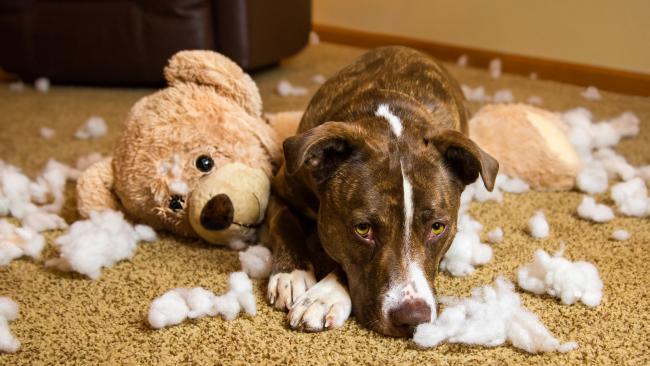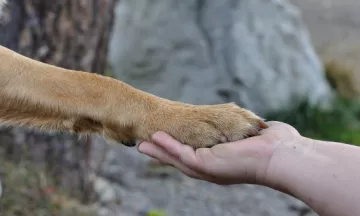If a new pet comes into your life or if a dog comes to visit you, it's important that your home is a pet-safe place and that you know your boundaries. We've created 2 convenient checklists to prepare your home for the arrival of a new pet - this will prevent damage to your property and keep the pet safe and sound.
Preparing your home for a dog is important for two reasons: first of all for the safety of the dog and secondly for the protection of your belongings. Also, if you are a dog sitter, keep in mind that it's a fact of life that pets can sometimes make a mess of your house - but the safety for your guest pet is the absolute priority #1.

To avoid any risks as much as you can, it's smart to make your house dog-proof. Think about stuff like:
- Door & stair gates to regulate room access
- Store electrical cords and outlets
- Clean up your place properly, hide all shoes, store small chewable items
- Bring fragile items and valuables to safety
- Keep toxic plants completely out of reach
- Close doors of cabinets and dryers/washing machines (for cats - always check before turning on)
- Make sure that the garbage bin is absolutely out of reach
- Store toxic cleaning solutions, medicines, batteries etc
- Remove expensive rugs
- Buy some ecological detergent + wipes / tissues
Leaving a dog alone
Damage often damage occurs when we leave a dog unattended. In addition, when a dog is alone he or she can feel stressed, creating coping behavior such as barking, scratching doors, chewing on your brand new shoes.
If you are welcoming a guest dog into your home as a dog sitter, keep in mind that the dog may feel uncomfortable or nervous in this new environment. Suppose a dog can normally be home alone for 4 hours without any problems. When the dog is at this strange new household, he or she may not be alone for even 5 minutes without feeling uneasy and lonely. This might provoke problem behavior or stress signals: annoying the neighbors by barking, or chewing up your stuff. Many dogs feel more comfortable in a crate or cage when they are alone. However, crate training does take time and effort. What if your dog is not used to staying in a crate? In this case, do not leave the dog alone in a crate when with the pet sitter either.
Is your dog going to stay with a pet sitter? Start with a test-day first. Then you can all experience how the dog actually behaves in a new environment. Read all about how much time you need for a dog as a pet owner and a pet sitter here.
House rules: what is allowed at your place?
Clear house rules are important for the safety of the dog, as they give the dog guidance and peace of mind. Of course, rules are also good for you: through proper training, you can teach your dog how to live peacefully alongside your belongings and to be friendly with housemates or visitors and other pets.
Before the guest dog arrives at your place, decide what your rules are. Discuss these with the pet owner if you are a pet sitter:
- Which areas of your house are accessible for the dog?
- Can the dog use your furniture? Is he or she allowed on your bed?
- Does the dog get snacks from you while you eat your meals? How do you respond to begging behavior?
- Where do you feed and reward the dog?
- Can the dog jump up to visitors?
Whether you take a dog in your home permanently or only temporarily as a guest pet: it is important that the dog feels comfortable with you. Moreover, rules are meant to make life more pleasant for both you and the dog. Remember that a dog just wants to be friends with you, and sometimes doesn't follow the rules because he or she either does not understand or has yet to learn. So do not yell at or punish a dog. Instead, reward the dog for good behavior. Simply say a firm 'no' when he shows undesirable behavior and offer an alternative. For example: is the dog chewing your shoe? Say 'no', take the shoe away. Put the dog on his bed or in his crate and give him a tasty chew snack.
When it comes to house rules, it is really important that you are consistent. This means that all members of the household must follow the same rules at all times. Are you welcoming a guest dog into your home? Then it's best to respect and follow the rules and commands that the dog is used to at home as much as possible. There is a little room for change though - can the dog stay on your couch at home, but not at the sitter's place? That doesn't have to be a problem. A dog can understand that in another environment, things run a little bit differently. Just keep in mind that the dog won't immediately understand, so be kind and patient and forgive any perceived 'disobedience' :-)
Taking your dog to the pet sitter
If you take your dog to a pet sitter, discuss the house rules with the sitter and share how your dog behaves normally. And be super honest too: can your dog sometimes be grumpy to children or other pets? Does your dog ever scratch doorposts or chew on your stuff? Does he or she like to jump on your bed with muddy paws? This is all very normal dog behavior, but it is important that the sitter can properly prepare for this. Discuss it with each other: what are your agreements in case of damage to the property? If you have an open discussion about these issues, the better your dog can enjoy a wonderful stay. Because yes, pets can be a bit messy, but they also bring a lot of love and warmth into your home.





